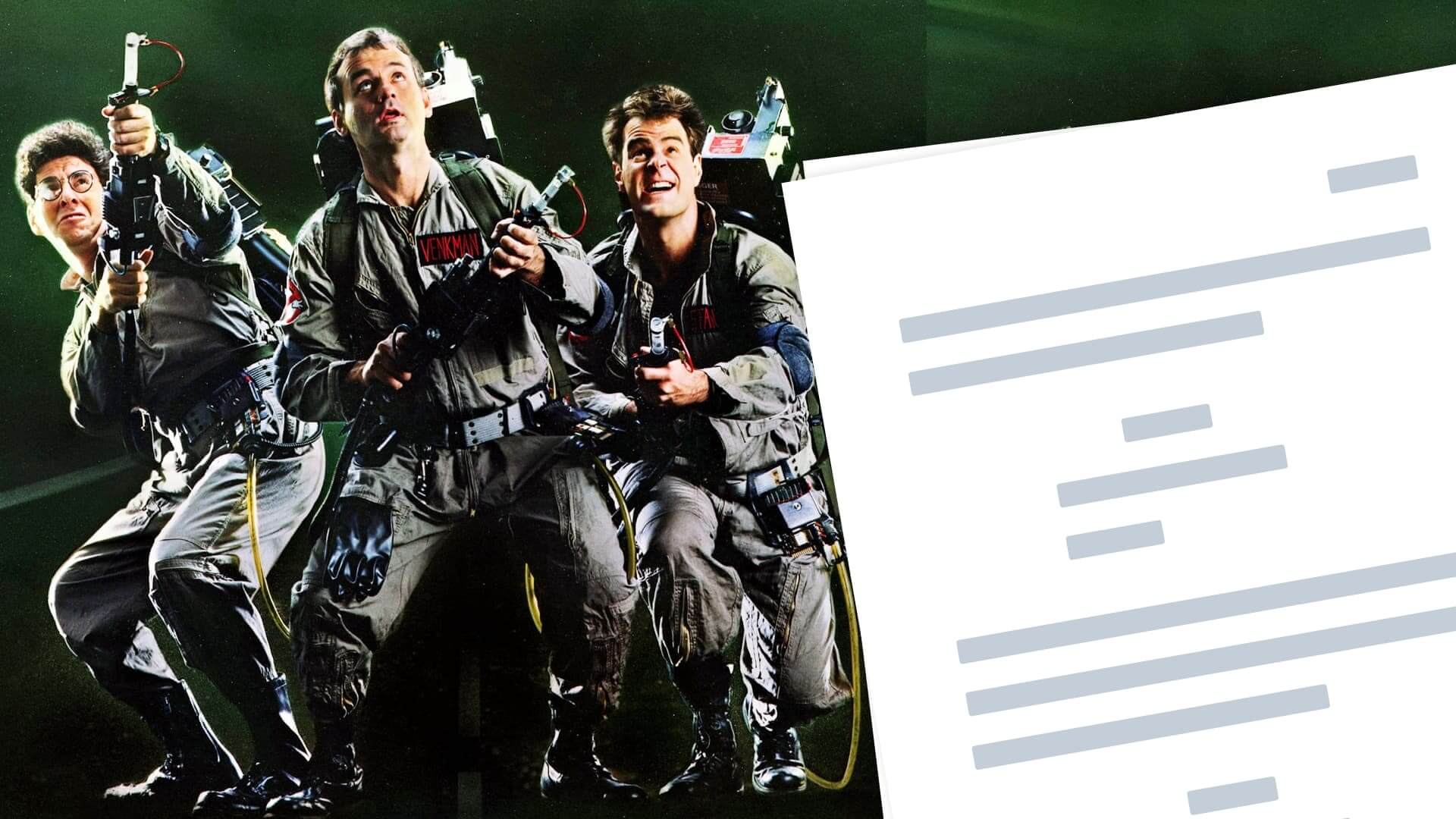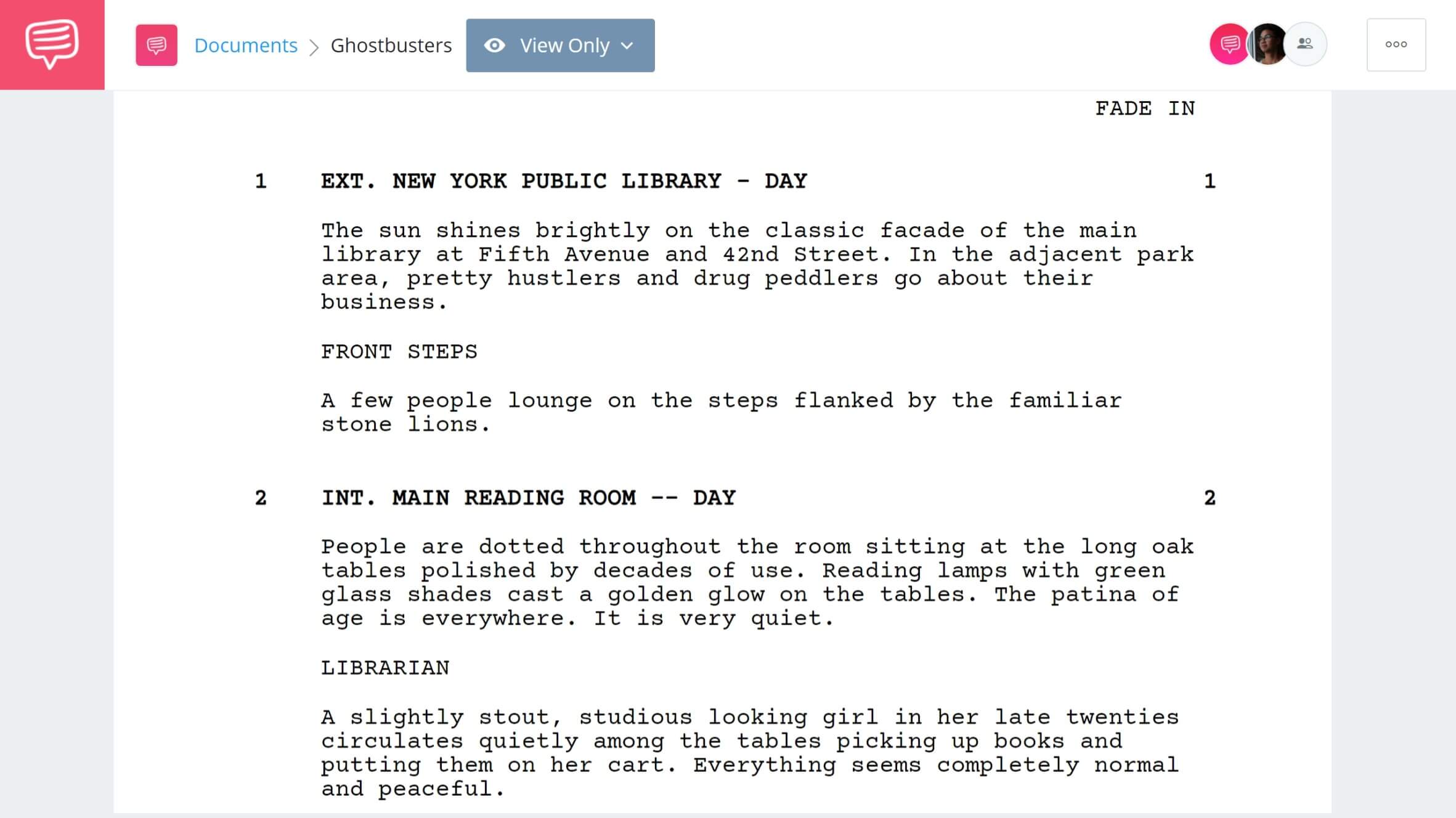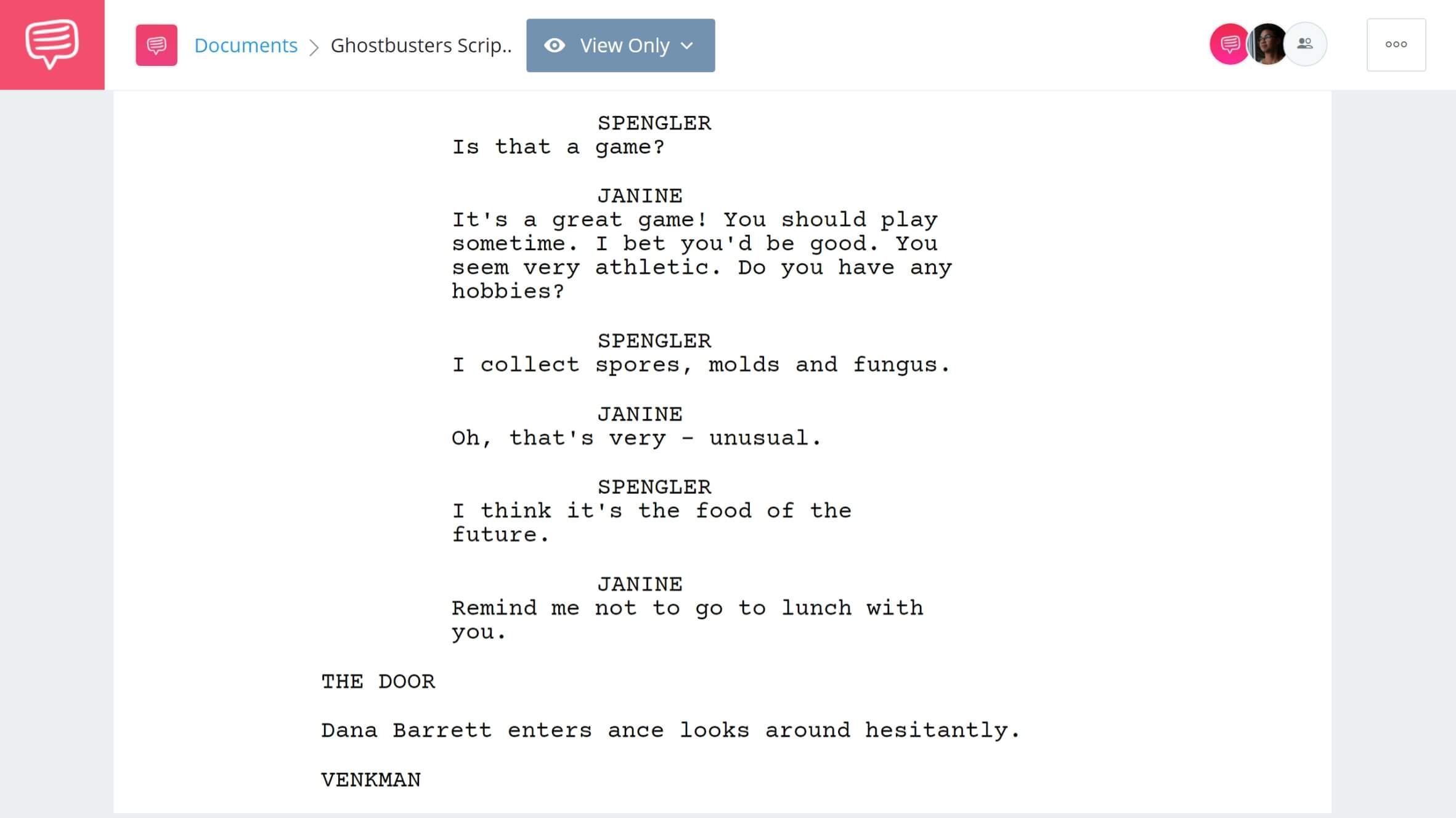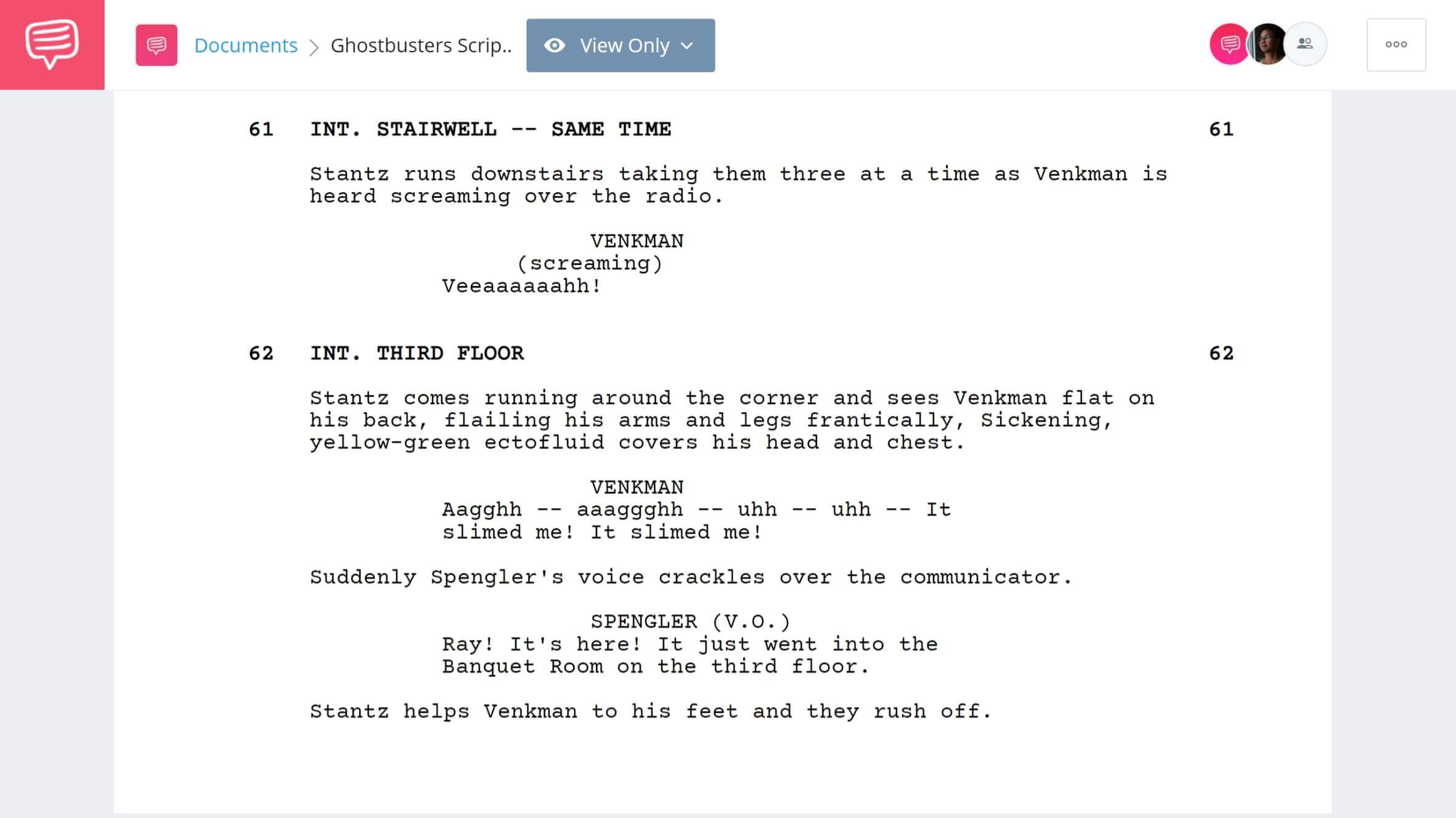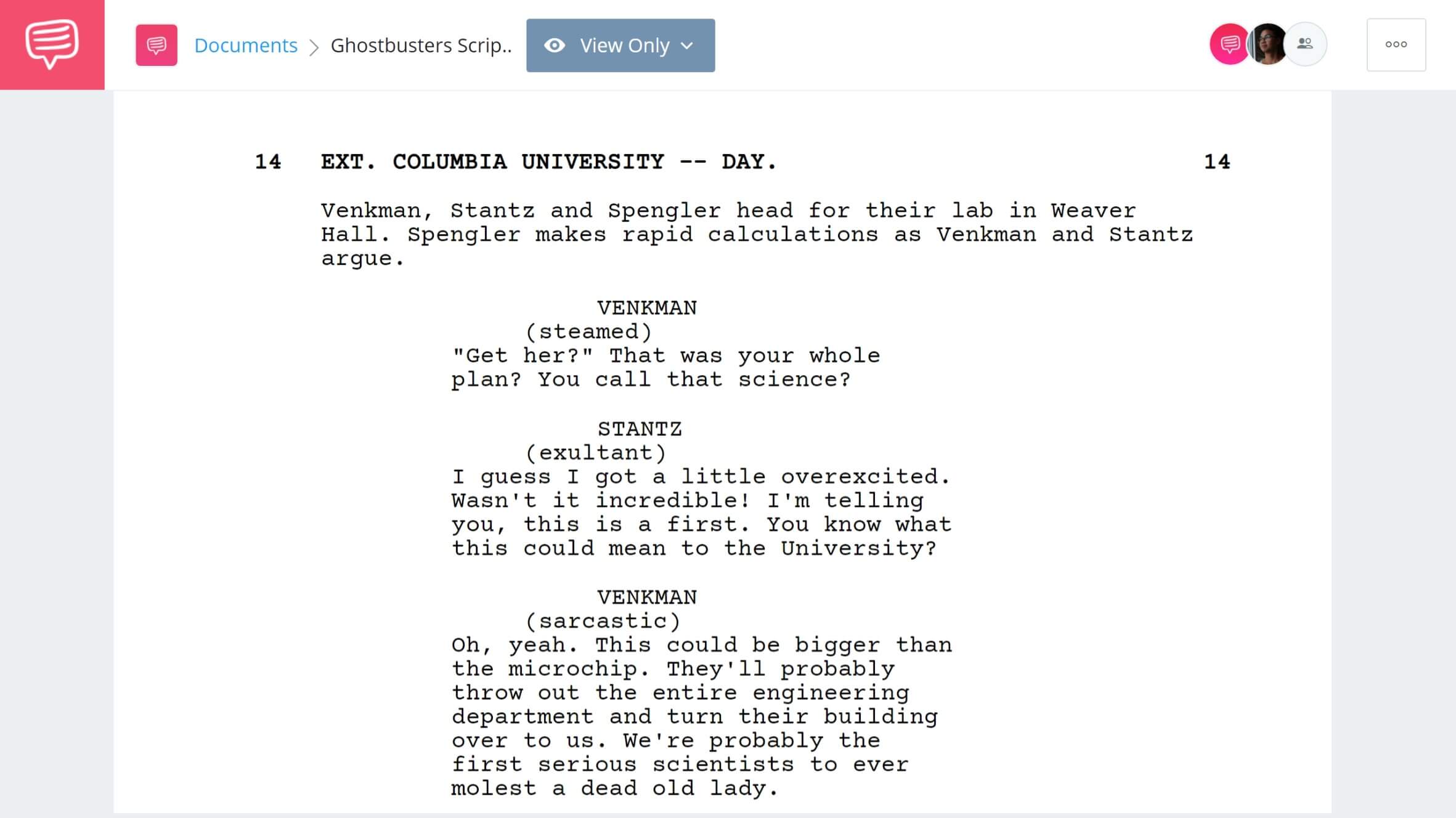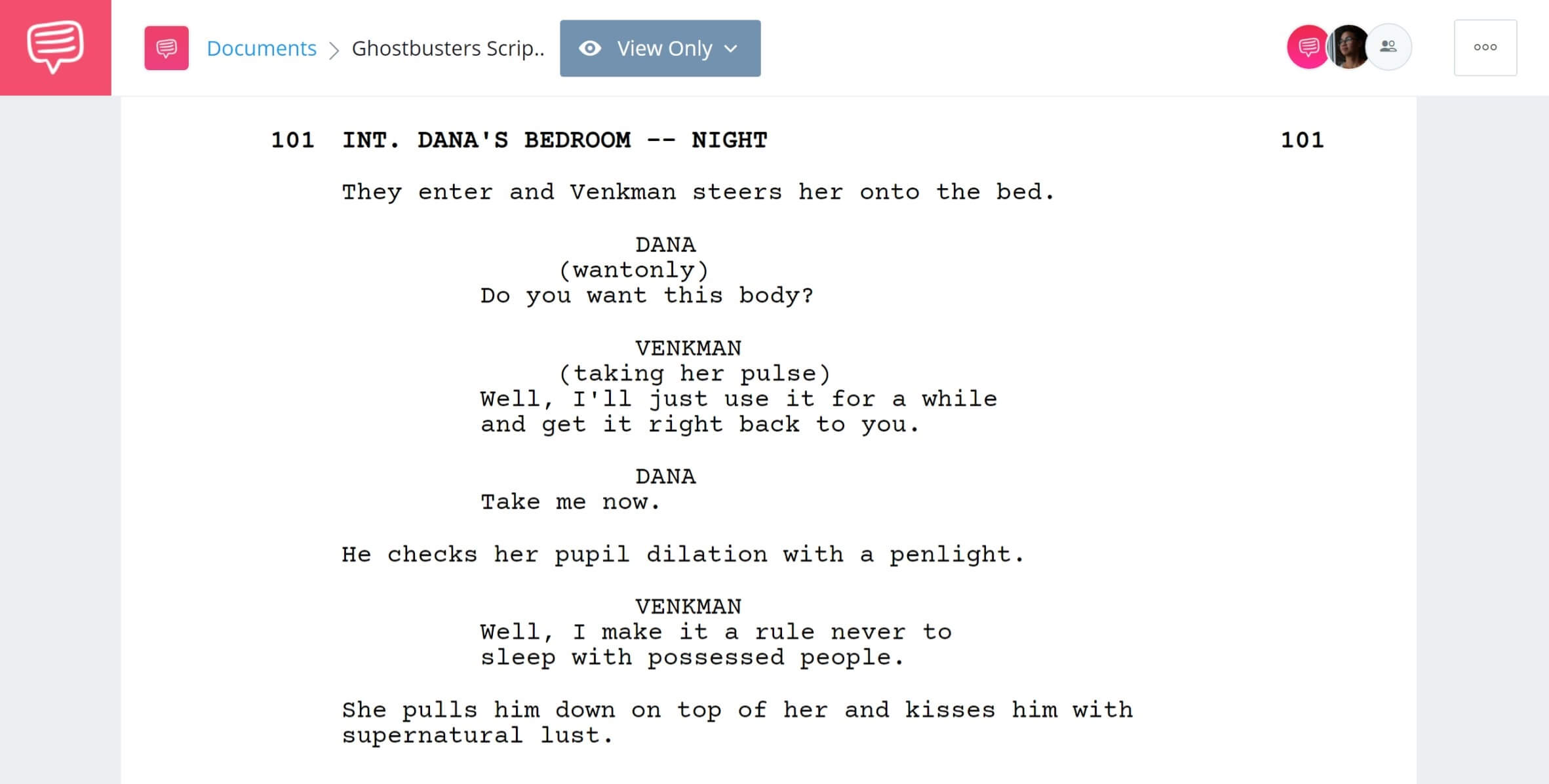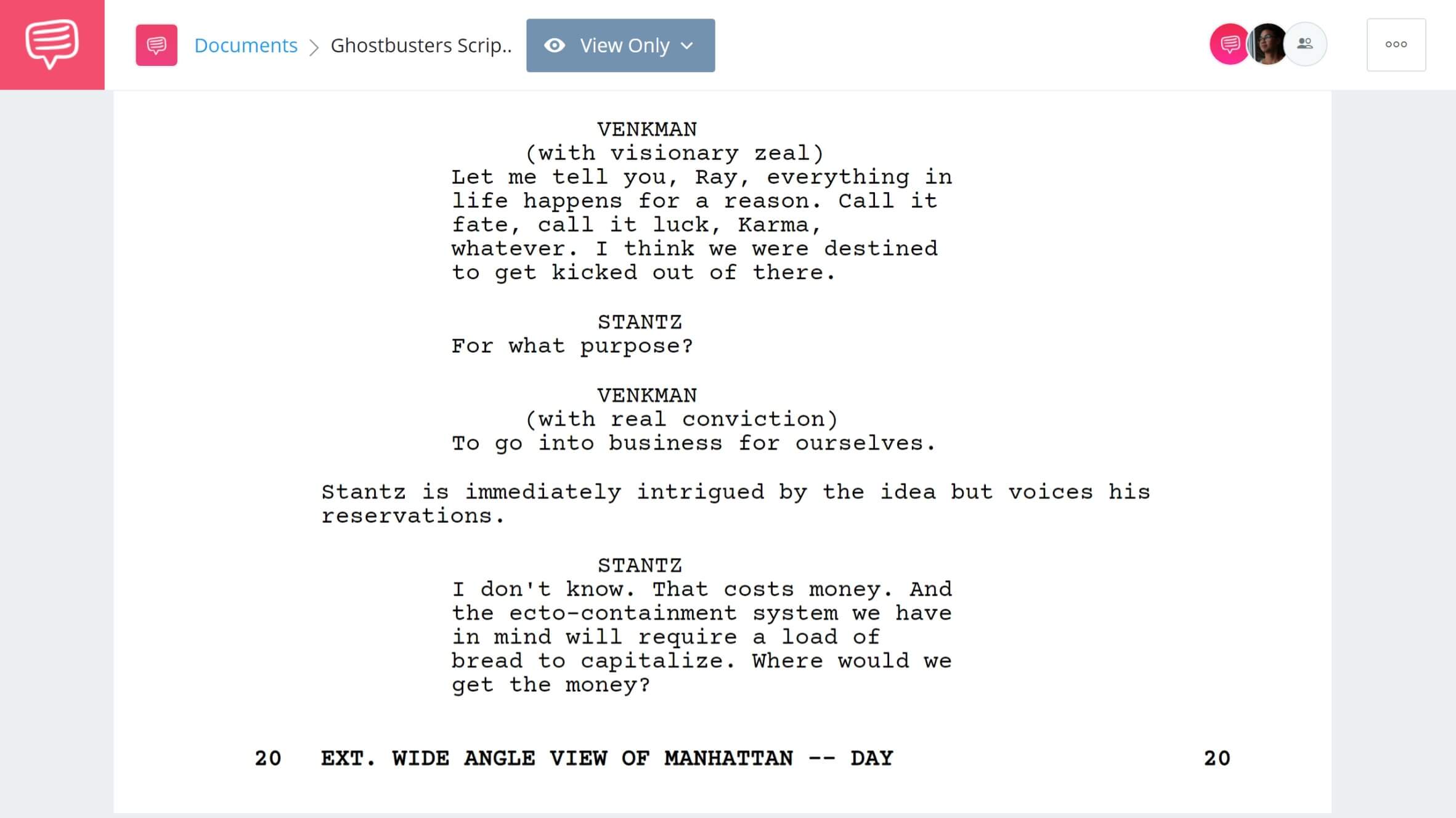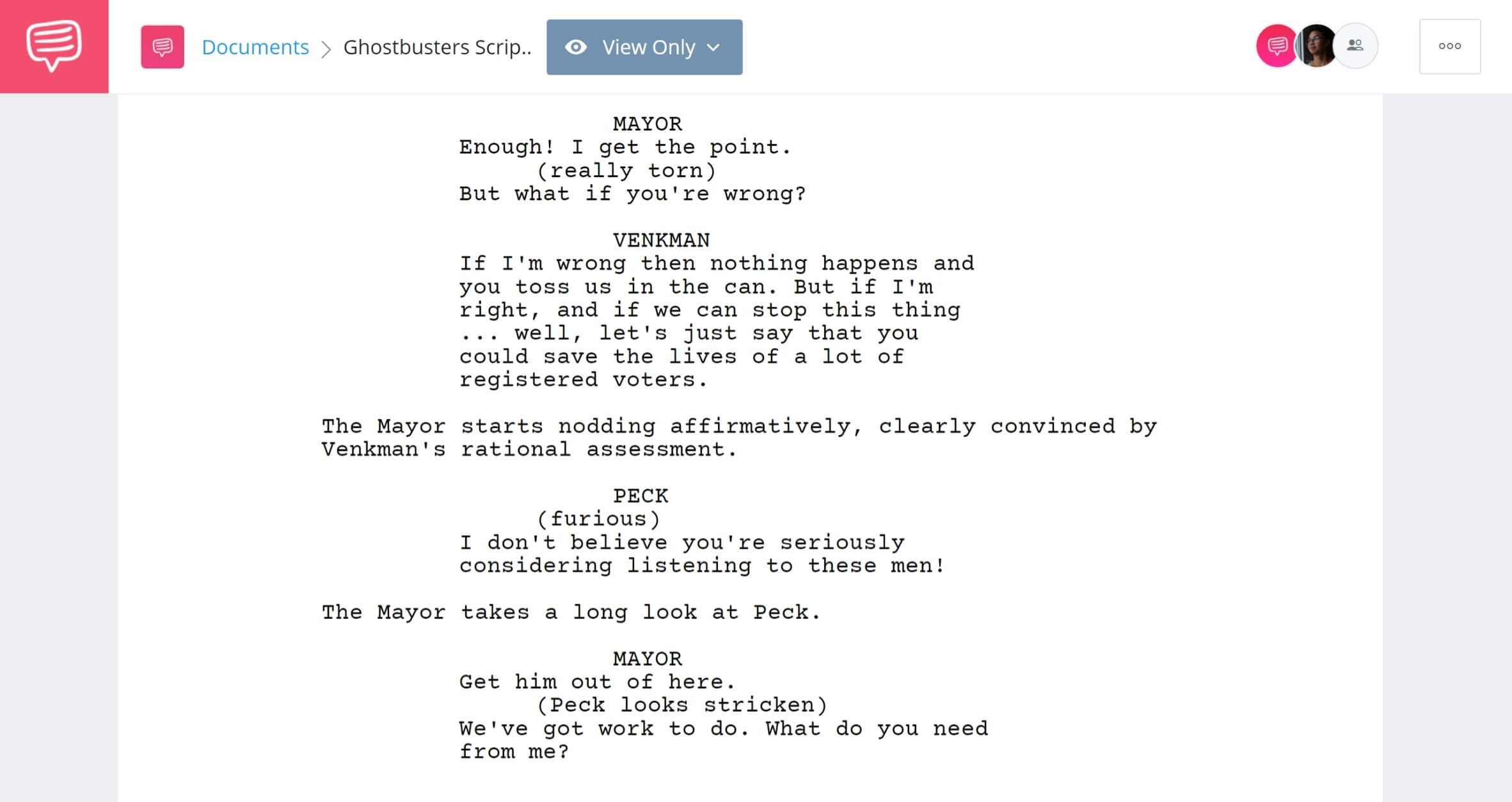Since the mid-’80s, few films have entered the pop cultural landscape and stayed there like Ghostbusters. A strong comedic cast, talented director, and a memorable theme song catapulted the movie to the history books. And to paraphrase Peter Venkman, the franchise rights alone made them rich beyond their wildest dreams. But it all had to come from somewhere, which is why we will be looking at the Ghostbusters script. We’ll be going over who wrote Ghostbusters and see how the script, while a little different from the final film, provided the basis for memorable quotes, characters, and themes.
WHO WROTE ghostbusters' SCRIPT?
Written by Dan Aykroyd and Harold Ramis
Dan Aykroyd is a Canadian comedian, actor, writer, producer, director, musician, and even businessman. He got his big start on Saturday Night Live, which included the creation of the Blues Brothers with John Belushi. While the Blues Brothers proved popular, he would later conceive of Ghostbusters, further catapulting his stardom and solidifying his stamp on pop culture with two of the best ‘80s movies of all time. He starred or was featured in a number of other movies for the next couple decades, including Ghostbusters II.
Harold Ramis was an American comedian, actor, writer, producer, and director. While primarily known for playing Egon Spengler in Ghostbusters and Ghostbusters II, Ramis had a strong career as a director, starting with Caddyshack (recognized as one of the best sports movies), and including National Lampoon’s Vacation, Groundhog Day, and Analyze This. Groundhog Day, while popular on release, has continued to receive immense acclaim as one of the best ‘90s movies of all time. It was even chosen by the Library of Congress to be preserved in the National Film Registry in 2006. Ramis passed away in 2014, after years of complications from autoimmune inflammatory vasculitis.
STORY BREAKDOWN
STRUCTURE OF the GHOSTBUSTERS SCREENPLAY
Here is the story structure for the Ghostbusters screenplay:
Exposition
Dr. Peter Venkman, Dr. Ray Stantz, and Dr. Egon Spengler work for a university. Stantz (very enthusiastic) and Egon (meticulous and stoic) are on the hunt for paranormal activity, while Venkman (sleazy and opportunistic) is a parapsychologist with a minimal-at-best interest in ghosts.
Inciting Incident
A librarian at the New York Public Library is spooked by an actual apparition, prompting the three to seek it out. While the trip proves useful, they are kicked out of the university (mainly because of Venkman). But with renowned freedom, Venkman encourages Stantz and Egon to go into business for themselves as ghost catchers.
Plot Point One
The three busters start up their business right around the same time as one Dana Barrett is experiencing paranormal activity in her apartment. The ghostbusters look into Barrett’s situation; they don’t find anything just yet, but they are going to look into it.
Rising Action
Finally, the Ghostbusters get an actual call to bust some ghosts. This successful case turns into many, as the ghostbusters take over New York City as high profile exterminators, from interviews to news articles wondering about ghost’s civil rights.
Midpoint
Winston Zeddemore joins the ghostbusters and E.P.A. man Walter Peck is inquiring about the Ghostbuster’s effect on the environment. Meanwhile, Venkman and the gang did manage to learn more about whatever is going on at Barrett’s apartment, with Venkman asking her out for dinner to talk about it.
Plot Point Two
Two statues on Barrett’s apartment building come to life and take over the body’s of both Barrett and her nerdy neighbor, Louis Tully. While Venkman encounters a possessed Barrett, Egon talks to possessed Louis and realizes they’re both connected to whatever is going on with the apartment. At the same time, Peck comes back to the Ghostbusters HQ and demands their field generator be shut off, resulting in a storm of released phantasms on the city.
Build Up
The ghostbusters are locked up but soon released, as the mayor doesn’t know how to handle the “freed ghosts” situation. The 'busters explain the situation and how it will bring about the end of the world. Realizing he may not have another option, the mayor allows the 'busters to get their gear and take care of business.
Climax
The Ghostbusters make it to Barrett’s apartment and encounter Gozer, who is here to destroy the city (and world). Gozer asks them to choose “the form of the destructor,” and Stantz unintentionally chooses the Stay-Puft Marshmallow Man. The busters decide it’s time to destroy Gozer more directly by attacking the interdimensional portal on the apartment roof.
Finale
The Ghostbusters manage to save the day, Venkman rescues Barrett, and they end the movie as heroes (at least, that is, until the sequel).
For more, explore an exciting collection of sci-fi movie scripts in our dedicated series. Dive in now to discover a world of captivating science fiction stories!
Ghostbusters Script Takeaway #1
Ghostbusters Quotes
A movie like Ghostbusters is one its fans can quote for days, to the point where you can even communicate in Ghostbusters dialogue. And when writing the original Ghostbusters script, Ramis knew that improvisation would be part of the deal, especially when working with Bill Murray.
As a result, the final film has dialogue that isn’t actually in the script, a lot of which does come from Murray. That said, the script is still funny, and some of the best lines in the film are still here, either exactly as is or in some variation. When we put the script into StudioBinder’s screenwriting software, we can see these lines in action.
Egon Spengler’s interaction with secretary Janine Melnitz gives us an amusing exchange, along with the famous “spores, molds and fungus” line. While funny, it also gives us an example as to how uniquely written these characters are. Janine is a more “normal” person than Spengler ever could be, to the point where he doesn’t notice, or possibly care.
Ghostbusters script 1984 • Read the scene here
For a great comparison of how a classic quote evolved from script to screen, we can take a look at the moment when Venkman is slimed by Slimer. The script is pretty straightforward, as Venkman announces he’s been slimed and Egon announces Slimer is now in the ballroom.
Ghostbusters 1984 script • Read the whole scene here
As far as the script goes, these lines get the job done to let us know Slimer is on the loose and Venkman got “attacked.” But as you can see in the clip below, the film expands the moment a bit. Murray’s deadpan and defeated delivery is contrasted by Aykroyd’s visible excitement for “actual physical contact!” Even Spengler (who tells them Slimer is in the ballroom) gets a comedic moment when he stoically asks for a sample.
Original Ghosbusters script comparison • Venkman gets slimed
Ghostbusters is an extremely quotable script, even if it doesn’t contain each and every famous line from the final film. For the famous quotes that aren’t there, you can get an idea of where they later stemmed from. And for the ones that are there, you can laugh and enjoy them as they are.
Some of the other fun quotes from the script include:
“Back off, man! I’m a scientist!”
“I’ve worked in the private sector. They expect results.”
“We’re ready to believe you.”
“Don’t cross the beams.”/ ”Cross the beams.”
“That’s a big Twinkie.”/ ”Tell him about the Twinkie.”
“Okay. Who brought the dog?”
“There is no Dana. I am Zuul.”
“It’s the Stay-Puft Marshmallow Man.”
Ghostbusters Script Takeaway #2
Ghostbusters Characters
Aside from the main premise, one thing that stays the same from script to screen in Ghostbusters are the characters. Venkman is the salesman type guy, Stantz is the enthusiastic one, and Spengler remains stoic and cool.
A great example of their differing personalities can be seen after the trio meets the ghost at the library. Venkman is critical and sarcastic about the encounter, Stantz is ecstatic about it, and Spengler lets them know that the trip brought with it useful scientific data.
Ghostbusters script PDF • Read the script here
For an example of one of the guys facing off against a ghost on their own, see the moment when Venkman encounters a possessed Dana Barrett.
Always the professional, Venkman realizes something is wrong and, instead of maybe taking advantage of the situation, he uses his parapsychology to try and help Dana. At the same time, Venkman uses humour to bring levity to a situation that is deathly serious by using his different skills to take control of what’s happening.
Ghostbusters script 1984 • Read the scene here
This scene in the final film plays out almost the same, with the addition of some Murray improv and being able to actually see possessed Dana in action. We can see how Murray adapts the moment from the script into the scene, along with how Sigourney Weaver pulls off being possessed.
Ghostbusters 1984 script comparison • Venkman and Zuul
There are obviously other characters in this movie: Walter Peck, the stuck up government beaurocrat; Winston Zeddemore, the most grounded guy in the group (who just joined for a paycheck); Louise Tully, a memorable and hilarious nerd; Janine Melnitz, a secretary who’s quit better jobs than being a Ghostbusters secretary. Each one has a role to play and fill, keeping the world of the Ghostbusters script unique and unforgettable.
Above all, the primary trio (latter quartet) are relatable everymen. They each have distinct personalities, ways of speaking, and approaches to things. This makes them that much more fun and easier to connect with, which is part of what makes the movie so enduring with kids and adults alike.
Ghostbusters Script Takeaway #3
Ghostbusters Themes
As fun as Ghostbusters is, its hidden strength is in its ability to be more than it seems. On the surface, it’s about a group of guys catching ghosts, and Dan Aykroyd’s original treatment will always reflect that. But as Lessons from the Screenplay explains in the video below, Ghostbusters managed to take that simple premise and do something unexpected with it: ground it in reality.
Ghostbusters • From script to screen
Placing it in New York City helps, as does making the heroes everyday joes who go into business for themselves after being fired from a university. That’s not only an inciting incident but something the audience can relate to. These aren’t superheroes, they’re regular guys who, as this excerpt from the script shows, know that starting a business, while appealing, isn’t easy.
Ghostbusters 1984 script • Read the rest of the scene here
Once the Ghostbusters business starts booming, government intervention tries to come in and ruin everything. This is obviously more political in nature, but it ties back to the “start a business” element that keeps the movie grounded. Walter Peck is the government stooge that wants to bureaucratically bring down the Ghostbusters. And since the Ghostbusters are the relatable heroes, it’s obvious that Peck and his court order are the bad guys who (unintentionally) help bring about “the destructor.”
Ghostbusters • Containment field explosion
It’s only after government incompetence brings back the ghosts that the mayor goes for the privately managed but voter-friendly option.
Ghostbusters script PDF • Read the whole scene here
In this way, whether the audience can tell or not, the heroes of the day are the relatable working class guys who took it upon themselves to find a solution for a problem no one else wanted to face or believe in. This is also a big reason why Ghostbusters was a big hit then and still a big hit now: relatable, down-to-earth characters and solutions going against paranormal and exaggerated problems. And the jokes don’t hurt, either.
Related Posts
UP NEXT
Read and download more scripts
The Ghostbusters script may have started as a wild Aykroyd idea, but thanks to his creativity and Ramis and Reitman keeping it grounded, a unique and beloved franchise was born. If you want to continue reading screenplays, we have similar titles like Jurassic Park, Back to the Future, and Inglourious Basterds in our screenplay database. Browse and download PDFs for all of our scripts as you read, write and practice your craft to become the next great screenwriter.
